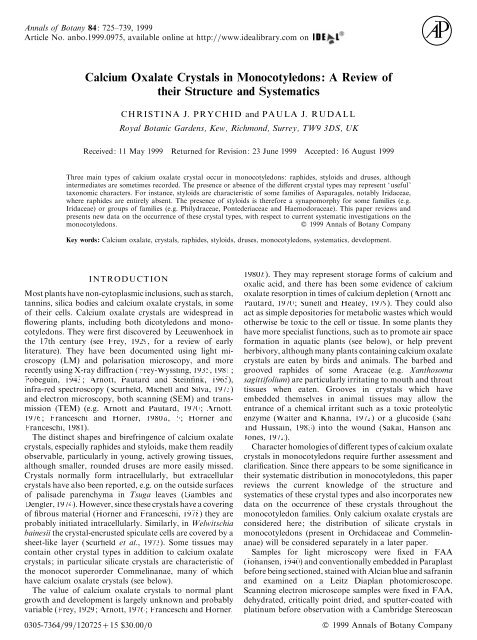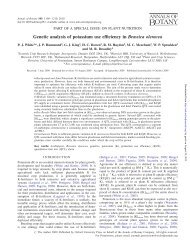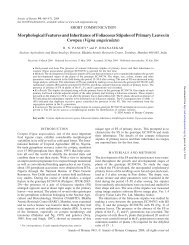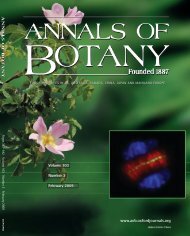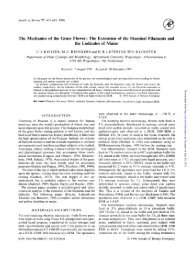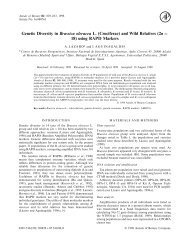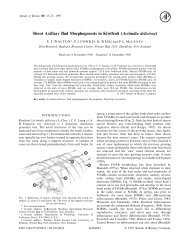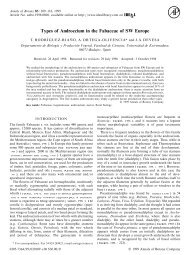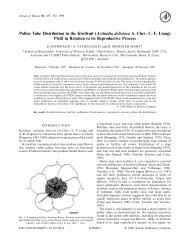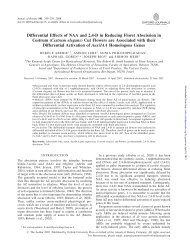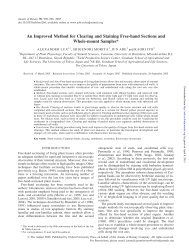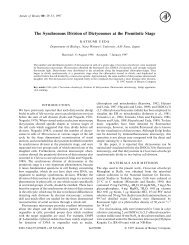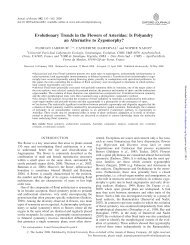Calcium Oxalate Crystals in Monocotyledons: A ... - Annals of Botany
Calcium Oxalate Crystals in Monocotyledons: A ... - Annals of Botany
Calcium Oxalate Crystals in Monocotyledons: A ... - Annals of Botany
You also want an ePaper? Increase the reach of your titles
YUMPU automatically turns print PDFs into web optimized ePapers that Google loves.
<strong>Annals</strong> <strong>of</strong> <strong>Botany</strong> 84: 725–739, 1999<br />
Article No. anbo.1999.0975, available onl<strong>in</strong>e at http:www.idealibrary.com on<br />
<strong>Calcium</strong> <strong>Oxalate</strong> <strong>Crystals</strong> <strong>in</strong> <strong>Monocotyledons</strong>: A Review <strong>of</strong><br />
their Structure and Systematics<br />
CHRISTINA J. PRYCHID and PAULA J. RUDALL<br />
Royal Botanic Gardens, Kew, Richmond, Surrey, TW9 3DS, UK<br />
Received: 11 May 1999 Returned for Revision: 23 June 1999 Accepted: 16 August 1999<br />
Three ma<strong>in</strong> types <strong>of</strong> calcium oxalate crystal occur <strong>in</strong> monocotyledons: raphides, styloids and druses, although<br />
<strong>in</strong>termediates are sometimes recorded. The presence or absence <strong>of</strong> the different crystal types may represent ‘useful’<br />
taxonomic characters. For <strong>in</strong>stance, styloids are characteristic <strong>of</strong> some families <strong>of</strong> Asparagales, notably Iridaceae,<br />
where raphides are entirely absent. The presence <strong>of</strong> styloids is therefore a synapomorphy for some families (e.g.<br />
Iridaceae) or groups <strong>of</strong> families (e.g. Philydraceae, Pontederiaceae and Haemodoraceae). This paper reviews and<br />
presents new data on the occurrence <strong>of</strong> these crystal types, with respect to current systematic <strong>in</strong>vestigations on the<br />
monocotyledons. 1999 <strong>Annals</strong> <strong>of</strong> <strong>Botany</strong> Company<br />
Key words: <strong>Calcium</strong> oxalate, crystals, raphides, styloids, druses, monocotyledons, systematics, development.<br />
INTRODUCTION<br />
Most plants have non-cytoplasmic <strong>in</strong>clusions, such as starch,<br />
tann<strong>in</strong>s, silica bodies and calcium oxalate crystals, <strong>in</strong> some<br />
<strong>of</strong> their cells. <strong>Calcium</strong> oxalate crystals are widespread <strong>in</strong><br />
flower<strong>in</strong>g plants, <strong>in</strong>clud<strong>in</strong>g both dicotyledons and monocotyledons.<br />
They were first discovered by Leeuwenhoek <strong>in</strong><br />
the 17th century (see Frey, 1929, for a review <strong>of</strong> early<br />
literature). They have been documented us<strong>in</strong>g light microscopy<br />
(LM) and polarisation microscopy, and more<br />
recently us<strong>in</strong>g X-ray diffraction (Frey-Wyssl<strong>in</strong>g, 1935, 1981;<br />
Pobegu<strong>in</strong>, 1943; Arnott, Pautard and Ste<strong>in</strong>f<strong>in</strong>k, 1965),<br />
<strong>in</strong>fra-red spectroscopy (Scurfield, Michell and Silva, 1973)<br />
and electron microscopy, both scann<strong>in</strong>g (SEM) and transmission<br />
(TEM) (e.g. Arnott and Pautard, 1970; Arnott,<br />
1976; Franceschi and Horner, 1980a, b; Horner and<br />
Franceschi, 1981).<br />
The dist<strong>in</strong>ct shapes and birefr<strong>in</strong>gence <strong>of</strong> calcium oxalate<br />
crystals, especially raphides and styloids, make them readily<br />
observable, particularly <strong>in</strong> young, actively grow<strong>in</strong>g tissues,<br />
although smaller, rounded druses are more easily missed.<br />
<strong>Crystals</strong> normally form <strong>in</strong>tracellularly, but extracellular<br />
crystals have also been reported, e.g. on the outside surfaces<br />
<strong>of</strong> palisade parenchyma <strong>in</strong> Tsuga leaves (Gambles and<br />
Dengler, 1974). However, s<strong>in</strong>ce these crystals have a cover<strong>in</strong>g<br />
<strong>of</strong> fibrous material (Horner and Franceschi, 1978) they are<br />
probably <strong>in</strong>itiated <strong>in</strong>tracellularly. Similarly, <strong>in</strong> Welwitschia<br />
ba<strong>in</strong>esii the crystal-encrusted spiculate cells are covered by a<br />
sheet-like layer (Scurfield et al., 1973). Some tissues may<br />
conta<strong>in</strong> other crystal types <strong>in</strong> addition to calcium oxalate<br />
crystals; <strong>in</strong> particular silicate crystals are characteristic <strong>of</strong><br />
the monocot superorder Commel<strong>in</strong>anae, many <strong>of</strong> which<br />
have calcium oxalate crystals (see below).<br />
The value <strong>of</strong> calcium oxalate crystals to normal plant<br />
growth and development is largely unknown and probably<br />
variable (Frey, 1929; Arnott, 1976; Franceschi and Horner,<br />
1980b). They may represent storage forms <strong>of</strong> calcium and<br />
oxalic acid, and there has been some evidence <strong>of</strong> calcium<br />
oxalate resorption <strong>in</strong> times <strong>of</strong> calcium depletion (Arnott and<br />
Pautard, 1970; Sunell and Healey, 1979). They could also<br />
act as simple depositories for metabolic wastes which would<br />
otherwise be toxic to the cell or tissue. In some plants they<br />
have more specialist functions, such as to promote air space<br />
formation <strong>in</strong> aquatic plants (see below), or help prevent<br />
herbivory, although many plants conta<strong>in</strong><strong>in</strong>g calcium oxalate<br />
crystals are eaten by birds and animals. The barbed and<br />
grooved raphides <strong>of</strong> some Araceae (e.g. Xanthosoma<br />
sagittifolium) are particularly irritat<strong>in</strong>g to mouth and throat<br />
tissues when eaten. Grooves <strong>in</strong> crystals which have<br />
embedded themselves <strong>in</strong> animal tissues may allow the<br />
entrance <strong>of</strong> a chemical irritant such as a toxic proteolytic<br />
enzyme (Walter and Khanna, 1972) or a glucoside (Saha<br />
and Hussa<strong>in</strong>, 1983) <strong>in</strong>to the wound (Sakai, Hanson and<br />
Jones, 1972).<br />
Character homologies <strong>of</strong> different types <strong>of</strong> calcium oxalate<br />
crystals <strong>in</strong> monocotyledons require further assessment and<br />
clarification. S<strong>in</strong>ce there appears to be some significance <strong>in</strong><br />
their systematic distribution <strong>in</strong> monocotyledons, this paper<br />
reviews the current knowledge <strong>of</strong> the structure and<br />
systematics <strong>of</strong> these crystal types and also <strong>in</strong>corporates new<br />
data on the occurrence <strong>of</strong> these crystals throughout the<br />
monocotyledon families. Only calcium oxalate crystals are<br />
considered here; the distribution <strong>of</strong> silicate crystals <strong>in</strong><br />
monocotyledons (present <strong>in</strong> Orchidaceae and Commel<strong>in</strong>anae)<br />
will be considered separately <strong>in</strong> a later paper.<br />
Samples for light microscopy were fixed <strong>in</strong> FAA<br />
(Johansen, 1940) and conventionally embedded <strong>in</strong> Paraplast<br />
before be<strong>in</strong>g sectioned, sta<strong>in</strong>ed with Alcian blue and safran<strong>in</strong><br />
and exam<strong>in</strong>ed on a Leitz Diaplan photomicroscope.<br />
Scann<strong>in</strong>g electron microscope samples were fixed <strong>in</strong> FAA,<br />
dehydrated, critically po<strong>in</strong>t dried, and sputter-coated with<br />
plat<strong>in</strong>um before observation with a Cambridge Stereoscan<br />
0305-73649912072515 $30.000 1999 <strong>Annals</strong> <strong>of</strong> <strong>Botany</strong> Company
726 Prychid and Rudall—<strong>Calcium</strong> <strong>Oxalate</strong> <strong>Crystals</strong> <strong>in</strong> <strong>Monocotyledons</strong><br />
S240. Samples for transmission electron microscopy were<br />
preserved us<strong>in</strong>g Karnovsky’s fixative (Glauert, 1975) and<br />
1% osmium tetroxide, dehydrated, embedded <strong>in</strong> LR White<br />
res<strong>in</strong>, sectioned and sta<strong>in</strong>ed with uranyl acetate and lead<br />
citrate (Reynolds, 1963) before observation with a JEOL<br />
JEM-1210.<br />
STRUCTURE AND SYSTEMATIC<br />
DISTRIBUTION<br />
<strong>Calcium</strong> oxalate crystals appear <strong>in</strong> a variety <strong>of</strong> shapes which<br />
are consistent and repeatable from one generation to the<br />
next, demonstrat<strong>in</strong>g that the physiological and genetic<br />
parameters controll<strong>in</strong>g them are consistent. There are three<br />
ma<strong>in</strong> types <strong>of</strong> calcium oxalate crystal <strong>in</strong> monocotyledons:<br />
raphides, styloids and druses, and these may be treated as<br />
three separate characters <strong>in</strong> cladistic analyses. The different<br />
types are sometimes, but not always, mutually exclusive.<br />
Raphides are by far the most common type <strong>in</strong> monocotyledons,<br />
and are <strong>of</strong>ten present at the same time as either<br />
druses or styloids (Table 1). Druses and styloids rarely occur<br />
together <strong>in</strong> the same plant, except occasionally <strong>in</strong> Acorus<br />
(Fig. 1A) and Araceae. Araceae is the only family <strong>in</strong> which<br />
all three ma<strong>in</strong> crystal types are recorded. Most monocotyledons<br />
have calcium oxalate crystals <strong>of</strong> some type, but<br />
they are entirely absent from some taxa, such as some<br />
families <strong>of</strong> Liliales, Poales and all Alismatidae (Table 1).<br />
Presence or absence <strong>of</strong> different crystal types <strong>in</strong> plants may<br />
therefore represent ‘useful’ taxonomic characters <strong>in</strong> some<br />
groups. For example, on the basis <strong>of</strong> both morphological<br />
and molecular characters, Rudall and Chase (1996) demonstrated<br />
that the genera formerly <strong>in</strong>cluded <strong>in</strong> Xanthorrhoeaceae<br />
sensu lato probably represent three dist<strong>in</strong>ct<br />
families: Xanthorrhoeaceae sensu stricto, Lomandraceae<br />
and Dasypogonaceae. The distribution <strong>of</strong> calcium oxalate<br />
crystals <strong>in</strong> these taxa reflects this taxonomy (Table 1):<br />
raphides are common <strong>in</strong> Lomandraceae, absent from<br />
Xanthorrhoeaceae, where they are replaced by styloids, and<br />
rare or absent <strong>in</strong> Dasypogonaceae, where silicate crystals<br />
(characteristic <strong>of</strong> Commel<strong>in</strong>anae) are present <strong>in</strong> the leaf<br />
epidermal cells.<br />
<strong>Calcium</strong> oxalate crystals occur either <strong>in</strong> a monohydrate<br />
(whewellite) form or a di- (or tri-) hydrate (wheddellite)<br />
form (Arnott, 1981). Raphides normally belong to the<br />
monocl<strong>in</strong>ic system with the whewellite or monohydrate<br />
form (Kohl, 1899), although, due to the narrowness <strong>of</strong> the<br />
needles, their large angles, and the curvature <strong>of</strong> the crystal<br />
face, this is <strong>of</strong>ten impossible to def<strong>in</strong>e without the aid <strong>of</strong><br />
X-ray diffraction (Frey-Wyssl<strong>in</strong>g, 1935, 1981; Pobegu<strong>in</strong>,<br />
1943; Arnott et al., 1965).<br />
<strong>Crystals</strong> may be present <strong>in</strong> almost every part <strong>of</strong> both<br />
vegetative and reproductive organs, <strong>of</strong>ten <strong>in</strong> crystal idioblasts<br />
near ve<strong>in</strong>s, possibly due to calcium be<strong>in</strong>g transported<br />
through the xylem, although experiments to demonstrate<br />
this have failed (Frank, 1967). Environmental conditions<br />
such as seasonal changes may <strong>in</strong>fluence the amount <strong>of</strong><br />
oxalate produced and the number <strong>of</strong> crystals formed.<br />
Aquatic plants <strong>of</strong>ten have calcium oxalate crystals associated<br />
with aerenchyma tissue, sometimes project<strong>in</strong>g <strong>in</strong>to air<br />
spaces: raphides (and sometimes druses) <strong>in</strong> Araceae (Fig.<br />
1B) and Typha, styloids <strong>in</strong> Eichhornia (Fig. 1C, D) and<br />
druses <strong>in</strong> Acorus (Fig. 1E, F). Indeed, crystals may be<br />
associated with air space formation: <strong>in</strong> young leaves <strong>of</strong><br />
Typha angustifolia, raphide crystal idioblasts circumscribe<br />
parenchymatous tissues which break down to form air space<br />
compartments. Cell wall plasticity may be <strong>in</strong>creased around<br />
air spaces, as calcium is sequestered with<strong>in</strong> crystal idioblasts<br />
(Kausch and Horner, 1981). Seubert (1997) found that, <strong>in</strong><br />
Araceae, raphides and sclereids seem to perform the same<br />
role and are present <strong>in</strong> <strong>in</strong>verse relative proportions: where<br />
many sclereids are present, raphides are few, and ice ersa.<br />
Mayo (1989) found that, <strong>in</strong> <strong>in</strong>floresences <strong>of</strong> Philodendron<br />
(Aracaeae), where both raphides and druses occur, druses<br />
are more common <strong>in</strong> the styles, whereas raphides are more<br />
common <strong>in</strong> aerenchymatous tissues.<br />
Raphides<br />
Raphides are bundles <strong>of</strong> narrow, elongated needle-shaped<br />
crystals, usually <strong>of</strong> similar orientation, with po<strong>in</strong>ted ends at<br />
maturity. Often (e.g. <strong>in</strong> Araceae) one end is abruptly<br />
po<strong>in</strong>ted whereas the other tapers to a po<strong>in</strong>t or is wedge<br />
shaped. There are vary<strong>in</strong>g numbers <strong>of</strong> crystals <strong>in</strong> each<br />
bundle. They are usually found <strong>in</strong> crystal idioblasts <strong>in</strong><br />
parenchymatous tissues (Fig. 2A, B), although there are<br />
examples <strong>of</strong> raphides occurr<strong>in</strong>g <strong>in</strong> specialized structures,<br />
such as aerenchyma (see above), or plant hairs. In<br />
Conanthera campanulata (Tecophilaeaceae) the uniseriate<br />
hairs fr<strong>in</strong>g<strong>in</strong>g the tepals conta<strong>in</strong> a bundle <strong>of</strong> raphides <strong>in</strong> each<br />
cell (Fig. 2C) and, similarly, raphides have been recorded <strong>in</strong><br />
trichomes <strong>of</strong> Cocos (Arecaceae) (Frey, 1929). In some<br />
species <strong>of</strong> Curculigo (Hypoxidaceae) numerous small,<br />
loosely arranged crystals are present <strong>in</strong> leaf epidermal cells,<br />
<strong>in</strong> addition to ‘normal’ bundles <strong>of</strong> raphides <strong>in</strong> mesophyll<br />
cells (Rudall et al., 1998a).<br />
Although most raphide crystals are four-sided (Fig. 3A),<br />
those <strong>of</strong> some taxa are at least six-sided, appear<strong>in</strong>g almost<br />
elliptical <strong>in</strong> cross section, for example <strong>in</strong> Yucca (Eilert,<br />
1974), Agae, Cordyl<strong>in</strong>e (Wattendorff, 1976b, 1979) and<br />
Ornithogalum (Tilton and Horner, 1980). In these taxa,<br />
raphides are <strong>in</strong>itially four-sided with wedge shaped ends but<br />
later develop <strong>in</strong>to six- and eight-sided crystals with po<strong>in</strong>ted<br />
ends (Fig. 3B). In Typha angustifolia (Kausch and Horner,<br />
1981), mature crystals are hexagonal towards their ends and<br />
octagonal <strong>in</strong> their central region. Dur<strong>in</strong>g development, each<br />
raphide becomes ensheathed <strong>in</strong> lamellae and surrounded by<br />
mucilage (see below). Addition <strong>of</strong> material to the ends <strong>of</strong> the<br />
raphides extends them from wedge-shaped to po<strong>in</strong>ted, and<br />
overlap <strong>of</strong> lamellae at these po<strong>in</strong>ted ends results <strong>in</strong><br />
characteristic w<strong>in</strong>g formations (Eilert, 1974; Wattendorff,<br />
1976b; Tilton and Horner, 1980; Horner, Kausch and<br />
Wagner, 1981).<br />
Grooved raphides occur <strong>in</strong> Araceae (Fig. 3C, D).<br />
Apparently all raphides <strong>in</strong> Araceae are grooved, <strong>in</strong>clud<strong>in</strong>g<br />
those <strong>of</strong> Spirodella (Ledbetter and Porter, 1970) and Lemna<br />
(Arnott, 1966; Arnott and Pautard, 1970), which are<br />
sometimes placed <strong>in</strong> a separate family, Lemnaceae. Grooved<br />
raphides therefore represent a significant apomorphy for<br />
Araceae. At <strong>in</strong>itiation, the crystals have a rounded appearance<br />
but are grooved at maturity. Ledbetter and Porter
Prychid and Rudall—<strong>Calcium</strong> <strong>Oxalate</strong> <strong>Crystals</strong> <strong>in</strong> <strong>Monocotyledons</strong> 727<br />
Table 1. Distribution <strong>of</strong> crystal types <strong>in</strong> monocotyledons (classification <strong>of</strong> Angiosperm Phylogeny Group 1998)<br />
Family Crystal type<br />
Acorales<br />
Acoraceae Raphides absent (e.g. Gulliver, 1863–1865); small druses present <strong>in</strong> stems and flowers<br />
<strong>of</strong> A. gram<strong>in</strong>eus and A. calamus (this paper: Fig. 1A, F), recorded as ‘crystall<strong>in</strong>e<br />
granules’ by Gulliver (1865). Small rhomboidal styloids sometimes present <strong>in</strong> bundle<br />
sheath cells (Fig. 1A)<br />
Arales<br />
Alismatidae (Alismataceae, Aponogetonaceae,<br />
Butomaceae, Cymodoceaceae, Hydrocharitaceae,<br />
Juncag<strong>in</strong>aceae, Limnocharitaceae, Posidoniaceae,<br />
Potamogetonaceae, Ruppiaceae, Scheuchzeriaceae,<br />
Zosteraceae<br />
<strong>Crystals</strong> absent (e.g. Gulliver, 1863–1865; S<strong>in</strong>gh, 1965; Toml<strong>in</strong>son, 1982), except small<br />
rods or styloids recorded <strong>in</strong> Butomus (Stant, 1967), and crystals sometimes present <strong>in</strong><br />
Hydrocharitaceae (Shaffer-Fehre, 1987)<br />
Araceae Both raphides and druses commonly present (e.g. Gulliver, 1863–1865; Johow, 1880;<br />
Wakker, 1888; Sakai et al., 1972; Gaiser, 1923; Genua and Hillson, 1985; Grayum,<br />
1990). Crystal sand also reported (see Frey, 1929; Grayum, 1990). Styloids present <strong>in</strong><br />
a few taxa, both elongated (<strong>in</strong> Zamioculcadeae) and rhomboidal (<strong>in</strong> Potheae and<br />
Monsteroideae) (Grayum, 1990; Seubert, 1997)<br />
T<strong>of</strong>ieldiaceae Raphides absent; small druses present (e.g. Gulliver, 1863–1865; this paper)<br />
Unplaced (non commel<strong>in</strong>oid) taxa<br />
Corsiaceae Raphides absent (Ru bsamen, 1986; this paper)<br />
Japanoliriaceae <strong>Crystals</strong> absent (this paper)<br />
Petrosaviaceae Raphides reported by Groom (1895), but not confirmed by Toml<strong>in</strong>son (1982) or this<br />
paper, although druse-like crystals observed here <strong>in</strong> Petrosaia borneensis and P.<br />
sakuraii<br />
Triuridaceae <strong>Crystals</strong> absent (Toml<strong>in</strong>son, 1982; and this paper: Sciaphila spp.)<br />
Asparagales<br />
Agavaceae (<strong>in</strong>clud<strong>in</strong>g Hosta) Raphides and styloids present (Gulliver, 1863–1865; Arnott, 1966, 1981; Sakai and<br />
Hanson, 1974; Wattendorff, 1976a, b; Dahlgren and Clifford, 1982; McDougall et<br />
al., 1993)<br />
Alliaceae Raphides and styloids present (Ricci, 1963; Arnott, 1981; Kausch and Horner, 1982);<br />
crystals absent <strong>in</strong> a few species <strong>of</strong> Allium (Gulliver, 1864); occasional druse-like<br />
crystals recorded <strong>in</strong> Allium (Ricci, 1963)<br />
Amaryllidaceae Raphides present (Dahlgren and Clifford, 1982); occasional druses reported by Johow<br />
(1880)<br />
Anemarrhenaceae Raphides present (Conran and Rudall, 1998)<br />
Anthericaceae Raphides present (e.g. Dahlgren and Clifford, 1982). In Chlorophytum comosum,<br />
druses reported by Kenda (1961), but styloids found <strong>in</strong> material exam<strong>in</strong>ed here (this<br />
paper)<br />
Aphyllanthaceae Raphides present (Dahlgren and Clifford, 1982)<br />
Asparagaceae (<strong>in</strong>cl. Hemiphylacus) Raphides present (e.g. Gulliver, 1863–1865; Rudall et al., 1998b)<br />
Asphodelaceae Both raphides and styloids present (e.g. Rudall and Cutler, 1995)<br />
Asteliaceae Raphides present (Rudall et al., 1998a)<br />
Behniaceae Raphides present (Conran, 1998a)<br />
Blandfordiaceae <strong>Crystals</strong> absent (Rudall et al., 1998a)<br />
Boryaceae Raphides present (Conran, 1998b)<br />
Convallariaceae s.l. (<strong>in</strong>clud<strong>in</strong>g Dracaenaceae,<br />
Eriospermaceae Nol<strong>in</strong>aceae, Ruscaceae)<br />
Both raphides and styloids and <strong>in</strong>termediate forms present (Gulliver, 1863–1865;<br />
Rothert and Zalenski, 1899; Dahlgren and Clifford, 1982; Cutler, 1992; this paper)<br />
Doryanthaceae Raphides absent; styloids present (Dahlgren and Clifford, 1982)<br />
Hemerocallidaceae s.l. (<strong>in</strong>cl. Phormiaceae and<br />
Johnsoniaceae)<br />
<strong>Crystals</strong> absent <strong>in</strong> Simethis, recorded as present or absent <strong>in</strong> Hemerocallis; <strong>in</strong><br />
Phormium raphides absent and styloids present (e.g. Gulliver, 1863–1865; Dahlgren<br />
and Clifford, 1982; Rudall and Cutler, 1995)<br />
Herreriaceae Raphides present, styloids absent (Rudall and Cutler, 1995)<br />
Hyac<strong>in</strong>thaceae Raphides present (Gulliver, 1863, 1864; Tilton, 1978; Tilton and Horner, 1980;<br />
Kausch and Horner, 1982; Svoma and Greilhuber, 1988)<br />
Hypoxidaceae Raphides present, styloids absent (Rudall et al., 1998a)<br />
Iridaceae Raphides absent, styloids present <strong>in</strong> most genera (e.g. Gulliver, 1863–1865; Goldblatt<br />
et al., 1984; Wu and Cutler, 1985; Wolter, 1990; Rudall, 1994, 1995), but absent<br />
from Sisyr<strong>in</strong>chium and its close allies (Rudall, Kenton and Lawrence, 1986)<br />
Occasional druses reported <strong>in</strong> Nienia conc<strong>in</strong>na (Rudall and Burns, 1989)
728 Prychid and Rudall—<strong>Calcium</strong> <strong>Oxalate</strong> <strong>Crystals</strong> <strong>in</strong> <strong>Monocotyledons</strong><br />
Table 1. (cont.)<br />
Family Crystal type<br />
Ixioliriaceae Raphides present, styloids absent (Rudall and Cutler, 1995)<br />
Lanariaceae Raphides absent, styloids sometimes present (Rudall, 1998)<br />
Laxmanniaceae ( omandraceae) Raphides present; styloids sometimes present (Rudall and Chase, 1996)<br />
<br />
Orchidaceae Raphides present, styloids absent (e.g. Gulliver, 1863–1865; Smith, 1923; Sandoval,<br />
1993; Pridgeon, 1994; Stern, 1997). Druse-like structures also present <strong>in</strong> Dendrobium<br />
aloifolium (Carlsward et al., 1997). Rhomboids present <strong>in</strong> stem ground tissue <strong>of</strong><br />
Platythelys ag<strong>in</strong>ata (Stern et al., 1993)<br />
Tecophilaeaceae Raphides present <strong>in</strong> most genera (Simpson and Rudall, 1998)<br />
Themidaceae Raphides present (this paper)<br />
Xanthorrhoeaceae Raphides absent, styloids present (Rudall and Chase, 1996)<br />
Xeronemataceae Raphides present (this paper)<br />
Liliales<br />
Alstroemeriaceae Raphides present; small crystals also present <strong>in</strong> Bomarea hirtella (this paper)<br />
Calochortaceae <strong>Crystals</strong> absent (e.g. Dahlgren and Clifford, 1982; Goldblatt et al., 1984)<br />
Campynemataceae Raphides present (Goldblatt et al., 1984)<br />
Colchicaceae (<strong>in</strong>clud<strong>in</strong>g some former Uvulariaceae) Raphides ma<strong>in</strong>ly absent (Gulliver, 1863–1865; Dahlgren and Clifford, 1982) although<br />
crystal sand recorded by Goldblatt et al. (1984) <strong>in</strong> some taxa (e.g. Uularia), and<br />
‘raphide bodies’ <strong>in</strong> Streptopus amplexifolius<br />
Liliaceae (<strong>in</strong>clud<strong>in</strong>g some former Uvulariaceae) Raphides absent (Gulliver, 1863–1865; Dahlgren and Clifford, 1982; Goldblatt et al.,<br />
1984; this paper). Druse-like crystals sometimes present <strong>in</strong> Tricyrtis latifolia (this<br />
paper)<br />
Luzuriagaceae (only Drymophila and Luzuriaga) Raphides present but rare <strong>in</strong> leaf mesophyll; styloids absent <strong>in</strong> Luzuriaga (Arroyo and<br />
Leuenberger, 1988). Raphides absent but small crystals present <strong>in</strong> Luzuriaga radicans<br />
(this paper)<br />
Melanthiaceae (<strong>in</strong>clud<strong>in</strong>g Trilliaceae, but exclud<strong>in</strong>g Raphides present (Gulliver, 1863–1865; Dahlgren and Clifford, 1982)<br />
T<strong>of</strong>ieldiaceae and Nartheciaceae)<br />
Philesiaceae Raphides present (Dahlgren and Clifford, 1982; this paper)<br />
Smilacaceae (<strong>in</strong>clud<strong>in</strong>g Ropogonaceae) Raphides present (Dahlgren and Clifford, 1982; this paper); small crystals also present<br />
<strong>in</strong> Smilax ch<strong>in</strong>a (this paper) and styloids and crystal sand (Guaglianone and Gattuso,<br />
1991)<br />
Dioscoreales<br />
Burmanniaceae Raphides absent (Ru bsamen, 1986)<br />
Dioscoreaceae (<strong>in</strong>clud<strong>in</strong>g Dioscorea, Rajania and Raphides normally present (Gulliver, 1863–1865; Ayensu, 1972); styloids normally<br />
Tamus)<br />
absent but rarely present (Ayensu, 1972); unusual t<strong>in</strong>y calcium oxalate crystals<br />
associated with starch gra<strong>in</strong>s recorded by Okoli and Green (1987) <strong>in</strong> seven species <strong>of</strong><br />
Dioscorea. Solitary crystals present <strong>in</strong> Dioscorea alata (Al-Rais et al., 1971); calcium<br />
oxalate present <strong>in</strong> stem sheath <strong>in</strong> Dioscorea (Xifreda, per. comm.); small crystals<br />
adjacent to vascular bundle <strong>in</strong> Dioscorea m<strong>in</strong>utiflora (this paper)<br />
Nartheciaceae Raphides absent (pers. obs.) or rarely present, reported by Gulliver (1863–1865) <strong>in</strong><br />
Narthecium<br />
Stenomeridaceae (Stenomeris) Raphides present (Ayensu, 1972)<br />
Thismiaceae Raphides present (Ru bsamen, 1986)<br />
Trichopodaceae (Trichopus, Aetra) Raphides present (Ayensu, 1972)<br />
Pandanales<br />
Cyclanthaceae Raphides and styloids present (Dahlgren and Clifford, 1982; Wilder, 1985); also small<br />
crystals present <strong>in</strong> Asplundia <strong>in</strong>signis (this paper)<br />
Pandanaceae Raphides present; also styloids crystals <strong>in</strong> Pandanus gasicus (Gulliver, 1863–1865;<br />
Dahlgren and Clifford, 1982; Huynh, 1989; this paper)<br />
Stemonaceae Raphides present; styloids present <strong>in</strong> Stemona (Ayensu, 1972)<br />
Velloziaceae Raphides possibly present (Dahlgren and Clifford, 1982); but reported as absent by<br />
Gulliver (1863–1865)<br />
Commel<strong>in</strong>oids: unplaced taxa<br />
Abolbodaceae <strong>Calcium</strong> oxalate crystals absent<br />
Bromeliaceae Raphides present (Toml<strong>in</strong>son, 1969; Dahlgren and Clifford, 1982; this paper)<br />
Dasypogonaceae <strong>Calcium</strong> oxalate crystals rare or absent (Rudall and Chase, 1996)<br />
Hanguanaceae <strong>Calcium</strong> oxalate crystals absent or raphides rarely present (this paper)<br />
Mayacaceae <strong>Calcium</strong> oxalate crystals absent (Toml<strong>in</strong>son, 1969)
Prychid and Rudall—<strong>Calcium</strong> <strong>Oxalate</strong> <strong>Crystals</strong> <strong>in</strong> <strong>Monocotyledons</strong> 729<br />
Table 1. (cont.)<br />
Family Crystal type<br />
Rapateaceae <strong>Calcium</strong> oxalate crystals absent (Toml<strong>in</strong>son, 1969), although small crystals seen <strong>in</strong><br />
Cephalostemon rupestris (this paper)<br />
Commel<strong>in</strong>oids: Arecales<br />
Arecaceae Raphides present <strong>in</strong> all palms (Toml<strong>in</strong>son, 1961; We<strong>in</strong>er and Liese, 1995)<br />
Commel<strong>in</strong>oids: Commel<strong>in</strong>ales<br />
Commel<strong>in</strong>aceae Raphides present (Toml<strong>in</strong>son, 1969; Kausch and Horner, 1982; this paper)<br />
Haemodoraceae Raphides present <strong>in</strong> some taxa (Gulliver, 1863–1865; Dahlgren and Clifford, 1982),<br />
but rare or absent <strong>in</strong> others; styloids present <strong>in</strong> some taxa, e.g. <strong>in</strong> flowers <strong>of</strong><br />
Wachendorfia (this paper)<br />
Philydraceae Raphides and styloids present (Gulliver, 1863–1865; Dahlgren and Clifford, 1982)<br />
Pontederiaceae<br />
Commel<strong>in</strong>oids: Poales<br />
Raphides present (Sakai and Hanson, 1974; Kausch and Horner, 1981); also styloids<br />
(Gulliver, 1864; Dahlgren and Clifford, 1982)<br />
Anarthriaceae <strong>Calcium</strong> oxalate crystals rare or absent (Cutler, 1969; L<strong>in</strong>der and Rudall, 1993)<br />
Centrolepidaceae <strong>Calcium</strong> oxalate crystals absent (Cutler, 1969)<br />
Cyperaceae <strong>Calcium</strong> oxalate crystals rare or absent (Metcalfe, 1971)<br />
Ecdeiocoleaceae <strong>Calcium</strong> oxalate crystals absent (L<strong>in</strong>der and Rudall, 1993)<br />
Eriocaulaceae <strong>Calcium</strong> oxalate crystals present (Toml<strong>in</strong>son, 1969)<br />
Flagellariaceae Raphides absent (L<strong>in</strong>der and Rudall, 1993); calcium oxalate crystals present as small<br />
druse-like bodies (Toml<strong>in</strong>son, 1969)<br />
Jo<strong>in</strong>villeaceae <strong>Calcium</strong> oxalate crystals present (Toml<strong>in</strong>son, 1969)<br />
Juncaceae <strong>Calcium</strong> oxalate crystals absent (Gulliver, 1863–1865; Cutler, 1969)<br />
Poaceae <strong>Calcium</strong> oxalate crystals normally absent (e.g. Metcalfe, 1960; L<strong>in</strong>der and Rudall,<br />
1993), but occasionally present <strong>in</strong> Panicum species (Ellis, 1988), and druses present <strong>in</strong><br />
Phyllostachys iridi-glaucescens (this paper)<br />
Restionaceae <strong>Calcium</strong> oxalate crystals absent (Cutler, 1969)<br />
Sparganiaceae Raphides present (Cook and Nicholls, 1986); occasional druses also recorded <strong>in</strong><br />
Sparganium americanum (Kausch and Horner, 1981)<br />
Thurniaceae <strong>Calcium</strong> oxalate crystals absent (Cutler, 1969)<br />
Typhaceae Raphides present (Horner et al., 1981; Kausch and Horner, 1981; Rowlatt and<br />
Morshead, 1992)<br />
Xyridaceae<br />
Commel<strong>in</strong>oids: Z<strong>in</strong>giberales<br />
<strong>Calcium</strong> oxalate crystals absent (Gulliver, 1863–1865; Toml<strong>in</strong>son, 1969)<br />
Cannaceae <strong>Calcium</strong> oxalate crystals absent (Toml<strong>in</strong>son, 1969)<br />
Costaceae <strong>Calcium</strong> oxalate crystals absent (Toml<strong>in</strong>son, 1969)<br />
Heliconiaceae Raphides present (Toml<strong>in</strong>son, 1969); small crystals also present <strong>in</strong> mesophyll <strong>of</strong><br />
Heliconia rostrata<br />
Lowiaceae Raphides present (Toml<strong>in</strong>son, 1969)<br />
Marantaceae <strong>Calcium</strong> oxalate crystals absent (Toml<strong>in</strong>son, 1969)<br />
Musaceae Raphides present (Toml<strong>in</strong>son, 1969; Lott, 1976; McDougall et al., 1993)<br />
Strelitziaceae Raphides present (Toml<strong>in</strong>son, 1969)<br />
Z<strong>in</strong>giberaceae <strong>Calcium</strong> oxalate crystals normally absent (Toml<strong>in</strong>son, 1969), but raphides and styloids<br />
recorded <strong>in</strong> Aframomum melegueta, Amomum cardamomum, A. globosum, A. illosum<br />
(Berger, 1958)<br />
(1970) found that, <strong>in</strong> Spirodella oligorrhiza, the crystal<br />
chambers (raphidosomes) have an hour-glass outl<strong>in</strong>e <strong>in</strong><br />
transverse section, and crystal formation is <strong>in</strong>itiated between<br />
the two constrictions <strong>in</strong> the membrane pr<strong>of</strong>ile. A calcium<br />
pump at these po<strong>in</strong>ts concentrates Ca+ with<strong>in</strong> the chamber<br />
which then comb<strong>in</strong>es with free oxalate that has diffused <strong>in</strong>to<br />
the compartment. However, from our own work, grooved<br />
raphides <strong>in</strong> Araceae form with<strong>in</strong> rounded membrane<br />
chambers, suggest<strong>in</strong>g that some <strong>of</strong> the calcium gates<br />
channels have shut down, result<strong>in</strong>g <strong>in</strong> no crystal growth at<br />
these po<strong>in</strong>ts (the grooves <strong>of</strong> the crystals). Many cellular<br />
modifications occur dur<strong>in</strong>g the genesis <strong>of</strong> crystals, which is<br />
a highly complex process (Kausch and Horner, 1983).<br />
Raphides <strong>in</strong> Araceae may also be barbed, such as those <strong>of</strong><br />
Alocasia, Colocasia, Dieffenbachia and Xanthosoma, <strong>in</strong><br />
which the tips <strong>of</strong> the barbs are slightly hooked and oriented<br />
away from the taper<strong>in</strong>g end and towards the abruptly<br />
po<strong>in</strong>ted end <strong>of</strong> the raphide. The barbs alternate along
730 Prychid and Rudall—<strong>Calcium</strong> <strong>Oxalate</strong> <strong>Crystals</strong> <strong>in</strong> <strong>Monocotyledons</strong><br />
Fig. 1. Photomicrographs <strong>of</strong> the three ma<strong>in</strong> calcium oxalate crystal types present <strong>in</strong> monocotyledons. Bars 20 µm. A, Acorus calamus<br />
(Acoraceae) transverse section <strong>of</strong> rhizome show<strong>in</strong>g druses and styloids (arrowheads); B, idioblast <strong>in</strong> the stem <strong>of</strong> Peltandra irg<strong>in</strong>ica (Araceae) with<br />
raphides project<strong>in</strong>g <strong>in</strong>to an air space; C, D, styloids project<strong>in</strong>g <strong>in</strong>to <strong>in</strong>tercellular spaces <strong>in</strong> transverse sections <strong>of</strong> rhizome <strong>of</strong> Eichhornia crassipes<br />
(Pontederiaceae); E, F, idioblasts conta<strong>in</strong><strong>in</strong>g druses found around <strong>in</strong>tercellular spaces <strong>in</strong> Acorus calamus.
Prychid and Rudall—<strong>Calcium</strong> <strong>Oxalate</strong> <strong>Crystals</strong> <strong>in</strong> <strong>Monocotyledons</strong> 731<br />
Fig. 2. Raphides may be present <strong>in</strong> parenchymatous tissues (A, B) and <strong>in</strong> specialized structures (C). Bars 20 µm. A, SEM <strong>of</strong> a raphide bundle<br />
found <strong>in</strong> the ovary <strong>of</strong> Lachenalia bulbifera (Hyac<strong>in</strong>thaceae). Note that all raphides with<strong>in</strong> a bundle are all orientated <strong>in</strong> the same direction; B,<br />
raphides found <strong>in</strong> Liriope platyphylla; C, DIC photomicrograph show<strong>in</strong>g raphide bundles present <strong>in</strong> the uniserate hairs fr<strong>in</strong>g<strong>in</strong>g the tepals <strong>of</strong><br />
Conanthera campanulata (Tecophileaceae).<br />
opposite sides <strong>of</strong> a crystal giv<strong>in</strong>g a pseudo-helical appearance<br />
(Sakai, Hanson and Jones, 1972; Sakai and Hanson, 1974;<br />
Sakai and Nagao, 1980; Cody and Horner, 1983). Monocl<strong>in</strong>ic<br />
crystal structure partly determ<strong>in</strong>es the general direction<br />
<strong>of</strong> barb growth, although calcium concentration<br />
also plays a part.<br />
Absence <strong>of</strong> raphides represents a synapomorphy for some<br />
groups, such as some families <strong>of</strong> Liliales (Rudall et al.<br />
unpubl. res.), Poales and all Alismatidae (Table 1). Raphides<br />
are also absent from Acorus (Table 1), which was formerly<br />
<strong>in</strong>cluded <strong>in</strong> Araceae, but now placed <strong>in</strong> a separate family,<br />
Acoraceae, sister to the rest <strong>of</strong> the monocotyledons. In this<br />
respect it resembles some ‘ primitive’ dicotyledons, such as<br />
Piperales (Grayum, 1987); further review <strong>of</strong> this character<br />
among monocot outgroups is required.<br />
Styloids<br />
Styloids, also called prismatic crystals or ‘pseudoraphides’,<br />
are thicker than raphides and usually solitary<br />
with<strong>in</strong> a cell (Fig. 4A–D), although <strong>in</strong>termediate forms are<br />
recorded. The term styloid encompasses a broad morphological<br />
range. Styloids may have po<strong>in</strong>ted ends (Fig. 1C,<br />
D), or squared ends (Fig. 4B), and may be elongated or<br />
cuboidal. Some styloids are ‘tw<strong>in</strong>ned’ crystals, e.g. the<br />
arrow-shaped styloids <strong>of</strong> Iris pseudacorus (Kollbeck,<br />
Goldschmidt and Schro der, 1914). In Allium, Arnott (1981)<br />
recorded <strong>in</strong>terpenetrant tw<strong>in</strong> calcium oxalate crystals<br />
(styloids) and Frey (1929) and Ricci (1963) reported a<br />
morphological range <strong>of</strong> styloids <strong>in</strong> different species, <strong>in</strong>clud<strong>in</strong>g<br />
‘normal’ rhomboidal crystals, pyramidal crystals<br />
with irregular faces, small crystall<strong>in</strong>e granules, and long<br />
prisms, sometimes isolated, and sometimes gathered together<br />
to form a druse. Large crystals may have adher<strong>in</strong>g<br />
small crystals.<br />
In monocot leaves, styloids are usually found either <strong>in</strong><br />
parenchymatous bundle sheath cells around vascular strands<br />
or <strong>in</strong> crystal idioblasts <strong>in</strong> adjacent mesophyll tissues,<br />
although, <strong>in</strong> Xanthorrhoea, the styloids <strong>in</strong> the leaf are<br />
frequently epidermal (Rudall and Chase, 1996). In Iridaceae,<br />
elongated styloids occur <strong>in</strong> axially elongated mesophyll<br />
cells, and short cuboidal crystals <strong>in</strong> the shorter cells <strong>of</strong> the<br />
parenchymatous outer bundle sheaths; both types commonly<br />
occur <strong>in</strong> the same leaf (see below).<br />
Styloids are characteristic <strong>of</strong> some families <strong>of</strong> Asparagales<br />
(Lilianae) (Table 1), <strong>in</strong>clud<strong>in</strong>g some ‘higher’ asparagoids<br />
(Agavaceae, Alliaceae, some Convallariaceae sensu lato and<br />
Lomandraceae) and some ‘lower’ asparagoids (Asphodelaceae,<br />
Doryanthaceae, some Hemerocallidaceae sensu<br />
lato, Lanariaceae, Iridaceae and Xanthorrhoeaceae). Sometimes<br />
raphides and styloids are mutually exclusive (<strong>in</strong><br />
Doryanthaceae, Iridaceae, Xanthorrhoeaceae, Phormium),<br />
but <strong>in</strong> cases where both types occur (e.g. <strong>in</strong> Convallariaceae)<br />
<strong>in</strong>termediate forms can be present, with occasionally two or<br />
three crystals per cell. Styloids also represent a synapomorphy<br />
for some Commel<strong>in</strong>anae, especially Philydraceae<br />
and Pontederiaceae, and possibly also Haemodoraceae<br />
(Table 1), although more work is needed <strong>in</strong> this area.<br />
Styloids are a diagnostic feature <strong>of</strong> certa<strong>in</strong> families,<br />
notably Iridaceae. In Iridaceae, raphides are <strong>in</strong>variably<br />
absent but almost all taxa have styloids (Goldblatt, Henrich<br />
and Rudall, 1984; Rudall, 1994, 1995), with the exception <strong>of</strong><br />
Sisyr<strong>in</strong>chium and its close allies, which lack crystals<br />
altogether (Rudall and Burns, 1989; Goldblatt, Rudall and
732 Prychid and Rudall—<strong>Calcium</strong> <strong>Oxalate</strong> <strong>Crystals</strong> <strong>in</strong> <strong>Monocotyledons</strong><br />
Fig. 3. TEMs <strong>of</strong> cross sections <strong>of</strong> raphide idioblasts from a leaf <strong>of</strong> Aspidistra lurida (Convallariaceae) (A, B) and the ovary <strong>of</strong> Arisarum ulgare<br />
(Araceae) (C, D). Note the mucilage surround<strong>in</strong>g the immature raphides <strong>in</strong> A and C (arrows). Bars 5 µm. A, The immature crystals are ma<strong>in</strong>ly<br />
four-sided; B, the crystals have ma<strong>in</strong>ly six to eight sides <strong>in</strong> this mature raphide idioblast; C, D, grooved raphides occur <strong>in</strong> members <strong>of</strong> the<br />
Araceae.
Prychid and Rudall—<strong>Calcium</strong> <strong>Oxalate</strong> <strong>Crystals</strong> <strong>in</strong> <strong>Monocotyledons</strong> 733<br />
Fig. 4. Styloids tend to be solitary with<strong>in</strong> a cell. Bars 10 µm (A, C, D) or 100 µm (B). A, Styloids present <strong>in</strong> Freyc<strong>in</strong>etia jaanica (Pandanaceae).<br />
Note presence <strong>of</strong> extensions around edges <strong>of</strong> crystal; B, SEM <strong>of</strong> a large styloid <strong>in</strong> Chlorophytum comosum (Liliaceae). Such crystals could possibly<br />
have a structural function; C, D, TEMs <strong>of</strong> develop<strong>in</strong>g styloids <strong>in</strong> Iris ersicolor (Iridaceae) and Ruscus aculeatus (Ruscaceae) respectively. Note<br />
presence <strong>of</strong> membraneous chambers around the crystals (arrows).<br />
Henrich, 1990). Styloids vary considerably <strong>in</strong> size and<br />
shape; <strong>in</strong> cross section they may be square or rectangular,<br />
occasionally with the longer walls convex; <strong>in</strong> longitud<strong>in</strong>al<br />
section typically longer and slender (100–300 µm or longer),<br />
with po<strong>in</strong>ted, forked or sometimes square ends. In some<br />
Iridaceae, such as Bobartia (Strid, 1974), Dietes (Rudall,<br />
1983), Hexaglottis, Patersonia and Romulea (De Vos, 1970),<br />
short (16–25 µm long) more or less cuboidal crystals have<br />
been observed, usually <strong>in</strong> cells surround<strong>in</strong>g the sclerenchymatous<br />
bundle sheaths (Rudall, 1994). Wu and Cutler
734 Prychid and Rudall—<strong>Calcium</strong> <strong>Oxalate</strong> <strong>Crystals</strong> <strong>in</strong> <strong>Monocotyledons</strong><br />
Fig. 5. TEMs <strong>of</strong> druses <strong>in</strong> Monstera dubia (Araceae). The crystals themselves are lost dur<strong>in</strong>g the process<strong>in</strong>g leav<strong>in</strong>g an outl<strong>in</strong>e <strong>of</strong> their shape with<strong>in</strong><br />
the idioblast. Bars 10 µm.<br />
(1985) found that variation <strong>in</strong> styloid size and shape has<br />
some taxonomic application among species <strong>of</strong> Iris. Wolter<br />
(1990), <strong>in</strong> a comprehensive survey <strong>of</strong> corm tunics <strong>of</strong> Crocus<br />
species, found ‘typical’ elongated po<strong>in</strong>ted styloids <strong>in</strong> 90%<br />
<strong>of</strong> species, and square-ended or cuboidal (prismatic) crystals<br />
<strong>in</strong> the rest, the latter type occurr<strong>in</strong>g irregularly among the<br />
different sections <strong>of</strong> the genus. Styloids also occur <strong>in</strong> the<br />
Tasmanian genus Isophysis, which is probably the sister<br />
taxon to all other Iridaceae, and <strong>in</strong> the Madagascan<br />
saprophyte Geosiris, which was orig<strong>in</strong>ally placed <strong>in</strong> its own<br />
family, but has now been shown to belong with<strong>in</strong> Iridaceae<br />
(Goldblatt et al., 1987). Styloids are also present (and<br />
raphides absent) <strong>in</strong> Doryanthes (Doryanthaceae), one <strong>of</strong><br />
two monogeneric families which are now considered most<br />
closely related to Iridaceae, based on analysis <strong>of</strong> molecular<br />
data (Chase et al., 1995): <strong>in</strong> the other family, Ixioliriaceae<br />
(Ixiolirion), only raphides are recorded.<br />
In other families <strong>of</strong> Asparagales, both raphides and<br />
styloids and <strong>in</strong>termediate forms may be present, particularly<br />
<strong>in</strong> a group <strong>of</strong> closely related ‘higher’ asparagoid families:<br />
Agavaceae and Convallariaceae sensu lato (<strong>in</strong>clud<strong>in</strong>g Dracaenaceae,<br />
Nol<strong>in</strong>aceae and Ruscaceae) (Rothert and<br />
Zalenski, 1899; Cutler, 1992). Cutler (1992) recorded a<br />
range <strong>of</strong> crystal types <strong>in</strong> leaves <strong>of</strong> Liriope, Peliosanthes and<br />
Ophiopogon (Convallariaceae), from ‘normal’ raphide<br />
bundles, axially oriented <strong>in</strong> a cell, to variously oriented<br />
crystal ‘ plates’, fractured prisms and paired or grouped<br />
coarse styloids. At the species level, differences <strong>in</strong> calcium<br />
oxalate crystals were characters used to discrim<strong>in</strong>ate between<br />
Polygonatum cirrhifolium and Polygonatum erticillatum<br />
(Namba et al., 1991).<br />
Druses<br />
Druses (formerly called ‘sphæraphides’) are multiple<br />
crystals that are thought to have precipitated around a<br />
nucleation site to form a crystal conglomerate (Horner,<br />
Kausch and Wagner, 1981). The <strong>in</strong>dividual component<br />
crystals <strong>of</strong> a druse can also <strong>in</strong>clude contact tw<strong>in</strong>s. Both the<br />
monohydrate and dihydrate forms <strong>of</strong> calcium oxalate can<br />
form druses (Al-Rais, Myers and Watson, 1971; Franceschi<br />
and Horner, 1979). Druses may have a similar defensive<br />
function to that <strong>of</strong> raphides, as they also have sharp po<strong>in</strong>ts<br />
(Fig. 5A, B) result<strong>in</strong>g <strong>in</strong> considerable irritation if eaten.<br />
Druses are common <strong>in</strong> dicotyledons (see Frey, 1929) but<br />
relatively rare <strong>in</strong> monocotyledons, where they are almost<br />
entirely restricted to the first-branch<strong>in</strong>g taxa, Acorus, some<br />
Araceae and T<strong>of</strong>ieldia (Table 1). Although there are very<br />
few records <strong>of</strong> druses <strong>in</strong> the literature, <strong>in</strong> fact they are quite<br />
common <strong>in</strong> Acorus, especially <strong>in</strong> aerenchymatous tissues. In<br />
Araceae they may occur <strong>in</strong> conjunction with raphides<br />
(Table 1), <strong>in</strong> Aglaonema, Alocasia, Anthurium, Colocasia,<br />
Dieffenbachia, Hydrosme, Philodendron, Pistia, Sc<strong>in</strong>dapsus,<br />
Spathiphyllum, Symplocarpus, Syngonium and Zantedechia<br />
(Gaiser, 1923; Sakai et al., 1972; Kausch and Horner, 1981;<br />
Sunell and Healey, 1981; Genua and Hillson, 1985). There<br />
are also a few other records <strong>of</strong> druses <strong>in</strong> monocotyledons,<br />
e.g. <strong>in</strong> Chlorophytum, Dendrobium, Flagellaria, Phyllostachys<br />
and Sparganium (Table 1).
Prychid and Rudall—<strong>Calcium</strong> <strong>Oxalate</strong> <strong>Crystals</strong> <strong>in</strong> <strong>Monocotyledons</strong> 735<br />
DEVELOPMENT<br />
<strong>Crystals</strong> form with<strong>in</strong> vacuoles <strong>of</strong> actively grow<strong>in</strong>g cells and<br />
are usually associated with membrane chambers, complexes,<br />
lamellae, mucilage and fibrillar material (Fig. 6A–D). This<br />
material appears before the crystals are <strong>in</strong>itiated, <strong>in</strong>dicat<strong>in</strong>g<br />
that the development <strong>of</strong> crystal idioblasts is equivalent to<br />
other processes <strong>of</strong> normal differentiation go<strong>in</strong>g on <strong>in</strong> the<br />
plant body rather than a pathological event forced upon the<br />
cell by a crystal (Z<strong>in</strong>dler-Frank, 1980). Druses, which are<br />
multiple crystals (see above) are also associated with<br />
paracrystall<strong>in</strong>e bodies <strong>in</strong> their early developmental stages.<br />
These bodies, which are possibly prote<strong>in</strong>aceous, are the<br />
nucleation sites around which s<strong>in</strong>gle crystals grow to<br />
produce an aggregate druse crystal (Horner and Wagner,<br />
1980).<br />
Cells conta<strong>in</strong><strong>in</strong>g mature crystals <strong>of</strong>ten have a th<strong>in</strong>,<br />
peripheral layer <strong>of</strong> cytoplasm surround<strong>in</strong>g the central<br />
crystal-conta<strong>in</strong><strong>in</strong>g vacuole. Sheaths have been found to<br />
develop around some mature crystals; for example suberized<br />
sheaths occur around styloid crystals <strong>in</strong> Agae (Wattendorf,<br />
1976a) and cellulosic sheaths around those <strong>of</strong> Rhynchosia<br />
caribaea, a dicot legume (Horner and Z<strong>in</strong>dler-Frank, 1982).<br />
The production <strong>of</strong> wall material may be a result <strong>of</strong> a change<br />
<strong>in</strong> the metabolism <strong>of</strong> the cell that is similar to a wound<br />
response.<br />
The shape and growth <strong>of</strong> crystals is controlled by<br />
membranous crystal chambers (Figs 4C, D, 6A–C) which<br />
occur <strong>in</strong> the vacuole and with<strong>in</strong> which the calcium oxalate<br />
crystallizes (Arnott and Pautard, 1970). Develop<strong>in</strong>g crystals<br />
are coated with hydration layers (Nancollas and Gardner,<br />
1974) which may be repelled by hydrophobic prote<strong>in</strong>s<br />
andor lipids <strong>of</strong> the chamber membrane (Cody and Horner,<br />
1983). The chambers expand as the crystals with<strong>in</strong> them<br />
grow. In the case <strong>of</strong> the needle-like raphide crystals (see<br />
below) these membrane-limited chambers seem to l<strong>in</strong>k<br />
together to become part <strong>of</strong> an extensive <strong>in</strong>travacuolar<br />
membrane system which orientates the raphide needles (Fig.<br />
6D).<br />
Cody and Horner (1983) proposed a model for crystal<br />
growth. They postulated an <strong>in</strong>itial random distribution <strong>of</strong><br />
dissolved calcium and oxalate ions <strong>in</strong> the crystal chamber,<br />
which may come together to form a crystall<strong>in</strong>e configuration<br />
or ‘cluster’. These clusters break up and reform easily. As<br />
the concentration <strong>of</strong> the dissolved ions <strong>in</strong>creases, the crystal<br />
clusters may grow <strong>in</strong> size, rather than break up, such that<br />
crystal nuclei form. This <strong>in</strong>crease <strong>in</strong> concentration to the<br />
po<strong>in</strong>t <strong>of</strong> saturation is controlled by plant metabolism. The<br />
crystal nuclei redissolve unless they reach a stable ‘ critical<br />
size’, when their free energy is lower than that <strong>of</strong> the<br />
solution. As one crystal nucleus grows, it lowers the<br />
concentration <strong>of</strong> the dissolved ions <strong>in</strong> solution thus caus<strong>in</strong>g<br />
other precritical nuclei <strong>in</strong> the vic<strong>in</strong>ity to dissolve. This tends<br />
to restrict crystal growth to one crystal per chamber.<br />
Dur<strong>in</strong>g the growth <strong>of</strong> a s<strong>in</strong>gle crystal, successive layers <strong>of</strong><br />
ions are assembled on the lowest energy positions available<br />
on its surface. An ion may occupy an alternative, slightly<br />
higher, energy position, giv<strong>in</strong>g rise to a stack<strong>in</strong>g error. The<br />
structure is still stable and when successive layers <strong>of</strong> ions are<br />
laid <strong>in</strong> the new most stable configuration, a contact tw<strong>in</strong> will<br />
have been formed. The probability <strong>of</strong> tw<strong>in</strong> crystal formation<br />
<strong>in</strong>creases as the concentration <strong>of</strong> the dissolved ions <strong>in</strong> the<br />
crystal chamber <strong>in</strong>creases. S<strong>in</strong>ce the concentrations <strong>of</strong><br />
calcium and oxalate are governed by the plant’s own<br />
metabolism, which <strong>in</strong> turn is governed by its genetic<br />
makeup, a particular taxon can have a characteristic crystal<br />
shape (Franceschi and Horner, 1980b), although some<br />
species have different crystal types <strong>in</strong> adjacent cells.<br />
Crystal cell <strong>in</strong>duction and development have also been<br />
studied us<strong>in</strong>g cultured vegetative tissues which produce<br />
calcium oxalate crystals. Tissue-cultured crystal idioblasts<br />
that are adjacent or <strong>in</strong> close proximity conta<strong>in</strong> crystal<br />
bundles which bear no apparent orientation to each other,<br />
<strong>in</strong> contrast to <strong>in</strong>tact tissues (Franceschi and Horner, 1980a).<br />
Callus tissue grown <strong>in</strong> the dark generally produces more<br />
idioblasts than light-grown tissue, except <strong>in</strong> leaf primordia<br />
and young expand<strong>in</strong>g leaves where crystal idioblast production<br />
is high (Horner and Franceschi, 1981). Indeed, one<br />
<strong>of</strong> the major pathways suggested for oxalate synthesis<br />
is ia glycollate and photosynthesis (Hodgk<strong>in</strong>son, 1977;<br />
Franceschi and Horner, 1980b).<br />
Grooved raphides, which occur <strong>in</strong> Araceae (see above)<br />
are tw<strong>in</strong>ned crystals. Tw<strong>in</strong> raphides are thought (Cody and<br />
Horner, 1983) to have begun growth at one end <strong>of</strong> a<br />
develop<strong>in</strong>g raphide bundle. It is possible that the <strong>in</strong>ner<br />
surfaces <strong>of</strong> the membrane chambers <strong>in</strong> a vacuole have<br />
specific nucleation sites at which crystal growth is <strong>in</strong>itiated.<br />
It could be that paracrystall<strong>in</strong>e bodies, such as those that<br />
occur dur<strong>in</strong>g druse development, are associated with the<br />
crystal chambers. It is not known whether calcium ‘gates’<br />
or ‘ channels’ are positioned throughout the crystal chamber<br />
membrane or are located around the periphery <strong>of</strong> the<br />
chamber. In the former case, the ‘gates’ are closed<br />
successively to ma<strong>in</strong>ta<strong>in</strong> growth at the raphide tip, rather<br />
than throughout the develop<strong>in</strong>g crystal (Cody and Horner,<br />
1983).<br />
SUMMARY<br />
Three ma<strong>in</strong> types <strong>of</strong> calcium oxalate crystal occur <strong>in</strong><br />
monocotyledons: raphides, styloids and druses, although<br />
<strong>in</strong>termediates are sometimes recorded and more than one<br />
type may be present <strong>in</strong> a species. The absence <strong>of</strong> raphides,<br />
the most common crystal type <strong>in</strong> monocots, represents a<br />
synapomorphy <strong>in</strong> some groups, such as Alismatales, Poales<br />
and some Liliales. Raphides are bundles <strong>of</strong> narrow,<br />
elongated needle-shaped crystals usually found <strong>in</strong> crystal<br />
idioblasts <strong>in</strong> parenchymatous tissues. Most raphide crystals<br />
are four-sided but <strong>in</strong> some taxa they develop further <strong>in</strong>to at<br />
least six-sided crystals with po<strong>in</strong>ted ends. Grooved raphides<br />
are characteristic <strong>of</strong> Araceae.<br />
Styloids (‘pseudoraphides’) are thicker than raphides and<br />
usually solitary with<strong>in</strong> a cell. They may have po<strong>in</strong>ted or<br />
squared ends, and may be elongated or cuboidal. Styloids<br />
are characteristic <strong>of</strong> some families <strong>of</strong> Asparagales, notably<br />
Iridaceae, where raphides are entirely absent. The presence<br />
<strong>of</strong> styloids is therefore a synapomorphy for some families<br />
(e.g. Iridaceae) or groups <strong>of</strong> families (e.g. Philydraceae,<br />
Pontederiaceae and Haemodoraceae), and more detailed<br />
studies on this aspect may well prove worthwhile for<br />
systematic studies on these groups. In some other families
736 Prychid and Rudall—<strong>Calcium</strong> <strong>Oxalate</strong> <strong>Crystals</strong> <strong>in</strong> <strong>Monocotyledons</strong><br />
Fig. 6. TEMs <strong>of</strong> cross sections <strong>of</strong> raphide idioblasts <strong>of</strong> Aspidistra lurida (Convallariaceae) (A) and Alocasia micholitziana (Araceae) (B, C, D).<br />
Bars 1 µm (A, C, D) or 100 nm (B). A–C, Raphides form with<strong>in</strong> membraneous crystal chambers which control growth. Mucilage is also<br />
associated with the develop<strong>in</strong>g crystals; D, the membranes seem to l<strong>in</strong>k together to form 3-D networks which serve to orientate the crystals.
Prychid and Rudall—<strong>Calcium</strong> <strong>Oxalate</strong> <strong>Crystals</strong> <strong>in</strong> <strong>Monocotyledons</strong> 737<br />
both raphides, styloids and <strong>in</strong>termediate forms may be<br />
present, particularly <strong>in</strong> a group <strong>of</strong> closely related ‘higher’<br />
asparagoid families, such as Convallariaceae sensu lato and<br />
Agavaceae.<br />
Druses (‘sphæraphides’) are crystal conglomerates possibly<br />
formed around a nucleation site. They are common <strong>in</strong><br />
dicotyledons, relatively rare <strong>in</strong> monocotyledons, where they<br />
are almost restricted to some early-branch<strong>in</strong>g taxa such as<br />
Acorus, Araceae and T<strong>of</strong>ieldia.<br />
LITERATURE CITED<br />
Al-Rais AH, Myers A, Watson L. 1971. The isolation and properties <strong>of</strong><br />
oxalate crystals from plants. <strong>Annals</strong> <strong>of</strong> <strong>Botany</strong> 35: 1213–1218.<br />
Arnott HJ. 1966. Studies <strong>of</strong> calcification <strong>in</strong> plants. In: Fleisch H,<br />
Blackwood HJJ, Owens M, eds. Third european symposium on<br />
calcified tissues. New York: Spr<strong>in</strong>ger, 152–157.<br />
Arnott HJ. 1976. Calcification <strong>in</strong> higher plants. In: Watabe N, Wilbur<br />
KM, eds. The mechanisms <strong>of</strong> m<strong>in</strong>eralization <strong>in</strong> the <strong>in</strong>ertebrates and<br />
plants. Columbia: University <strong>of</strong> South Carol<strong>in</strong>a Press, 55–73.<br />
Arnott HJ. 1981. An SEM study <strong>of</strong> tw<strong>in</strong>n<strong>in</strong>g <strong>in</strong> calcium oxalate crystals<br />
<strong>of</strong> plants. Scann<strong>in</strong>g Electron Microscopy 3: 225–234.<br />
Arnott HJ, Pautard FGE. 1970. Calcification <strong>in</strong> plants. In: Schraer H,<br />
ed. Biological calcification; cellular and molecular aspects.<br />
Amsterdam: North-Holland, 375–446.<br />
Arnott HJ, Pautard FGE, Ste<strong>in</strong>f<strong>in</strong>k F. 1965. Structure <strong>of</strong> calcium<br />
oxalate monohydrate. Nature 208: 1197–1198.<br />
Arroyo SC, Leuenberger BE. 1988. Leaf morphology and taxonomic<br />
history <strong>of</strong> Luzuriaga (Philesiaceae). Willdenowia 17: 159–172.<br />
Ayensu ES. 1972. Anatomy <strong>of</strong> the monocotyledons. VI. Dioscoreales.<br />
Oxford: Oxford University Press.<br />
Berger F von. 1958. Zur Samenanatomie der Z<strong>in</strong>giberazeen-Gattungen<br />
Elettaria, Amomum und Aframomum. Scientia Pharmaceutica 26:<br />
224–258.<br />
Carlsward BS, Stern WL, Judd WS, Lucansky TW. 1997. Comparative<br />
leaf anatomy and systematics <strong>in</strong> Dendrobium sections Aporum and<br />
Rhizobium (Orchidaceae). International Journal <strong>of</strong> Plant Science<br />
158: 332–342.<br />
Chase MW, Duvall MR, Hills HG, Conran JG, Cox AV, Eguiarte LE,<br />
Hartwell J, Fay MF, Caddick LR, Cameron KM, Hoot S. 1995.<br />
Molecular systematics <strong>of</strong> Lilianae. In: Rudall PJ, Cribb PJ, Cutler<br />
DF, Humphries CJ, eds. <strong>Monocotyledons</strong>: systematics and eolution.<br />
Richmond, Surrey, UK: Royal Botanic Gardens Kew,<br />
109–137.<br />
Cody AM, Horner HT. 1983. Tw<strong>in</strong> raphides <strong>in</strong> the Vitaceae and<br />
Araceae and a model for their growth. Botanical Gazette 144:<br />
318–330.<br />
Conran J. 1998a. Behniaceae. In: Kubitzki K, ed. The families and<br />
genera <strong>of</strong> ascular plants. III. Flower<strong>in</strong>g plants. <strong>Monocotyledons</strong>.<br />
Berl<strong>in</strong>: Spr<strong>in</strong>ger-Verlag, 146–148.<br />
Conran J. 1998b. Boryaceae. In: Kubitzki K, ed. The families and<br />
genera <strong>of</strong> ascular plants. III. Flower<strong>in</strong>g plants. <strong>Monocotyledons</strong>.<br />
Berl<strong>in</strong>: Spr<strong>in</strong>ger-Verlag, 151–154.<br />
Conran J, Rudall PJ. 1998. Anemarrhenaceae. In: Kubitzki K, ed. The<br />
families and genera <strong>of</strong> ascular plants. III. Flower<strong>in</strong>g plants.<br />
<strong>Monocotyledons</strong>. Berl<strong>in</strong>: Spr<strong>in</strong>ger-Verlag, 111–114.<br />
Cook Ch DK, Nicholls MS. 1986. A monographic study <strong>of</strong> the genus<br />
Sparganium (Sparganiaceae). Part 1. Subgenus Xanthosparganum<br />
Holmberg. Part 2. Subgenus Sparganium. 96: 213–267, 1987 97:<br />
1–44.<br />
Cutler DF. 1969. Anatomy <strong>of</strong> the monocotyledons. IV. Juncaceae.<br />
Oxford: Oxford University Press.<br />
Cutler DF. 1992. Vegetative anatomy <strong>of</strong> Ophiopogonae (Convallariaceae).<br />
Botanical Journal <strong>of</strong> the L<strong>in</strong>nean Society 110: 385–419.<br />
Dahlgren RMT, Clifford HT. 1982. The monocotyledons, a comparatie<br />
study. London: Academic Press.<br />
De Vos MP. 1970. Contribution to the morphology and anatomy <strong>of</strong><br />
Romulea: the leaf. Journal <strong>of</strong> South African <strong>Botany</strong> 36: 271–286.<br />
Eilert GB. 1974. An ultrastructural study <strong>of</strong> the deelopment <strong>of</strong> raphide<br />
crystal cells <strong>in</strong> the roots <strong>of</strong> Yucca torreyii. PhD Thesis, University<br />
<strong>of</strong> Texas.<br />
Ellis RP. 1988. Leaf anatomy and systematics <strong>of</strong> Panicum (Poaceae:<br />
Panicoideae) <strong>in</strong> Southern Africa. Monographs <strong>in</strong> Systematic <strong>Botany</strong><br />
Missouri Botanical Garden 25: 129–156.<br />
Franceschi VR, Horner HT Jr. 1979. Use <strong>of</strong> Psychotria punctata callus<br />
<strong>in</strong> study <strong>of</strong> calcium oxalate crystal idioblast formation. Zeitschrift<br />
fu r Pflanzenphysiologie 92: 61–75.<br />
Franceschi VR, Horner HT Jr. 1980a. A microscopic comparison <strong>of</strong><br />
calcium oxalate crystal idioblasts <strong>in</strong> plant parts and callus cultures<br />
<strong>of</strong> Psychotria punctata (Rubiaceae). Zeitschrift fu r Pflanzenphysiologie<br />
97: 449–455.<br />
Franceschi VR, Horner HT Jr. 1980b. <strong>Calcium</strong> oxalate crystals <strong>in</strong><br />
plants. Botanical Reiew 46: 361–427.<br />
Frank E. 1967. Zur Bildung des Kristallidioblastenmusters bei<br />
Canaalia ensiformis DC. I. Zeitschrift fu r Pflanzenphysiologie 58:<br />
33–48.<br />
Frey A. 1929. <strong>Calcium</strong>oxalat-Monohydrat und Trihydrat. In:<br />
L<strong>in</strong>sbauer K, ed. Handbuch der Pflanzenanatomie Vol. 3. Berl<strong>in</strong>:<br />
Gebru der Borntraeger, 82–127.<br />
Frey-Wyssl<strong>in</strong>g A. 1935. Die St<strong>of</strong>fausscheidung der Ho heren Pflanzen.<br />
Berl<strong>in</strong>: Spr<strong>in</strong>ger.<br />
Frey-Wyssl<strong>in</strong>g A. 1981. Crystallography <strong>of</strong> the two hydrates <strong>of</strong><br />
crystall<strong>in</strong>e calcium oxalate <strong>in</strong> plants. American Journal <strong>of</strong> <strong>Botany</strong><br />
68: 130–141.<br />
Gaiser LO. 1923. Intracellular relations <strong>of</strong> aggregate crystals <strong>in</strong> the<br />
spadix <strong>of</strong> Anthurium. Bullet<strong>in</strong> <strong>of</strong> the Torrey Club 50: 389–398.<br />
Gambles RL, Dengler NG. 1974. The leaf anatomy <strong>of</strong> hemlock, Tsuga<br />
canadensis. Canadian Journal <strong>of</strong> <strong>Botany</strong> 52: 1049–1056.<br />
Genua JM, Hillson CJ. 1985. The occurrence, type and location <strong>of</strong><br />
calcium oxalate crystals <strong>in</strong> the leaves <strong>of</strong> 14 species <strong>of</strong> Araceae.<br />
<strong>Annals</strong> <strong>of</strong> <strong>Botany</strong> 56: 351–361.<br />
Glauert AM. 1975. Fixation, dehydration and embedd<strong>in</strong>g <strong>of</strong> biological<br />
specimens. Amsterdam: North-Holland Publish<strong>in</strong>g Company.<br />
Goldblatt P, Henrich JE, Rudall P. 1984. Occurrence <strong>of</strong> crystals <strong>in</strong><br />
Iridaceae and allied families and their phylogenetic significance.<br />
<strong>Annals</strong> <strong>of</strong> the Missouri Botanical Garden 71: 1013–1020.<br />
Goldblatt P, Rudall P, Henrich JE. 1990. The genera <strong>of</strong> the Sisyr<strong>in</strong>chium<br />
alliance (Iridaceae-Iridoideae): phylogeny and relationships.<br />
Systematic <strong>Botany</strong> 15: 497–510.<br />
Goldblatt P, Rudall P, Cheadle VI, Dorr LJ, Williams CA. 1987.<br />
Aff<strong>in</strong>ities <strong>of</strong> the Madagascan endemic genus Geosiris, Iridaceae or<br />
Geosiridaceae. Bullet<strong>in</strong> <strong>of</strong> the Muse e National d’Histoire Naturale,<br />
Paris, 4e se r., 9 sect. B, Adansonia 3: 239–248.<br />
Grayum MH. 1987. A summary <strong>of</strong> evidence and arguments support<strong>in</strong>g<br />
the removal <strong>of</strong> Acorus from the Araceae. Taxon 36: 723–729.<br />
Grayum MH. 1990. Evolution and phylogeny <strong>of</strong> the Araceae. <strong>Annals</strong> <strong>of</strong><br />
the Missouri Botanical Garden 77: 628–697.<br />
Groom P. 1895. On a new saprophytic monocotyledon. <strong>Annals</strong> <strong>of</strong><br />
<strong>Botany</strong> 9: 45–58.<br />
Guaglianone E, Gattuso S. 1991. Estudios taxonomico sobre el genero<br />
Smilax (Smilacaceae). Bolet<strong>in</strong> de la Sociedad Argent<strong>in</strong>a de Botanica<br />
27: 105–129.<br />
Gulliver G. 1863–1865. On raphides and sphaeraphides <strong>of</strong> Phanerogamia.<br />
<strong>Annals</strong> and Magaz<strong>in</strong>e <strong>of</strong> Natural History, ser. 3,11: 13–15;<br />
12: 226–229, 365–367; 13: 41–43, 119–121, 212–215, 292–295,<br />
406–409, 508–509; 15: 38–40, 211–212, 380–382, 456–458; 16:<br />
331–333.<br />
Hodgk<strong>in</strong>son A. 1977. In: Oxalic acid <strong>in</strong> biology and medic<strong>in</strong>e. London:<br />
Academic Press, Inc.<br />
Horner HT Jr, Franceschi VR. 1978. <strong>Calcium</strong> oxalate crystal formation<br />
<strong>in</strong> air spaces <strong>of</strong> the stem <strong>of</strong> Myriophyllum. Scann<strong>in</strong>g Electron<br />
Microscopy 2: 69–76.<br />
Horner HT Jr, Franceschi VR. 1981. The use <strong>of</strong> a tissue culture system<br />
as an experimental approach to the study <strong>of</strong> plant crystal cells.<br />
Scann<strong>in</strong>g Electron Microscopy 3: 245-249.<br />
Horner HT Jr, Wagner BL. 1980. The association <strong>of</strong> druse crystals with<br />
the develop<strong>in</strong>g stomium <strong>of</strong> Capsicum annuum (Solanaceae) anthers.<br />
American Journal <strong>of</strong> <strong>Botany</strong> 67: 1345–1360.<br />
Horner HT Jr, Z<strong>in</strong>dler-Frank E. 1982. <strong>Calcium</strong> oxalate crystals and<br />
crystal cells <strong>in</strong> the leaves <strong>of</strong> Rhynchosia caribaea (Legum<strong>in</strong>osae:<br />
Papilionoideae). Protoplasma 111: 10–18.
738 Prychid and Rudall—<strong>Calcium</strong> <strong>Oxalate</strong> <strong>Crystals</strong> <strong>in</strong> <strong>Monocotyledons</strong><br />
Horner HT Jr, Kausch AP, Wagner BL. 1981. Growth and change <strong>in</strong><br />
shape <strong>of</strong> raphide and druse calcium oxalate crystals as a function<br />
<strong>of</strong> <strong>in</strong>tracellular development <strong>in</strong> Typha angustifolia L. (Typhaceae)<br />
and Capsicum annuum L. (Solanaceae). Scann<strong>in</strong>g Electron Microscopy<br />
3: 251–262.<br />
Huynh K-L. 1989. Une espe ce nouvelle de Pandanus (Pandanaceae) du<br />
Mozambique. Botanica Heletica 99: 21–26.<br />
Johansen DA. 1940. Plant microtechnique. New York: McGraw Hill<br />
Book Co.<br />
Johow FR. 1880. Untersuchungen u ber die zellkerne <strong>in</strong> den secretbeha ltern<br />
und Parenchymzellen der ho heren Monocotylen. Bonn: Diss.<br />
Kausch AP, Horner HT Jr. 1981. The relationship <strong>of</strong> air space<br />
formation and calcium oxalate crystal development <strong>in</strong> young<br />
leaves <strong>of</strong> Typha angustifolia L. (Typhaceae). Scann<strong>in</strong>g Electron<br />
Microscopy 3: 263–272.<br />
Kausch AP, Horner HT Jr. 1982. A comparison <strong>of</strong> calcium oxalate<br />
crystals isolated from callus cultures and their explant sources.<br />
Scann<strong>in</strong>g Electron Microscopy I: 199–211.<br />
Kausch AP, Horner HT Jr. 1983. The development <strong>of</strong> mucilag<strong>in</strong>ous<br />
raphide crystal idioblasts <strong>in</strong> young leaves <strong>of</strong> Typha angustifolia L.<br />
(Typhaceae). American Journal <strong>of</strong> <strong>Botany</strong> 70: 691–705.<br />
Kenda G. 1961. E<strong>in</strong>schluβko rper <strong>in</strong> den Epidermiszellen von Chlorophytum<br />
comosum. Protoplasma 53: 305–319.<br />
Kohl FG. 1899. Untersuchungen u ber die Raphidenzellen. Botanische<br />
Centralblatt 79: 273–282.<br />
Kollbeck F, Goldschmidt VM, Schro der R. 1914. U ber Whewellit.<br />
Beitrage Kristallographie M<strong>in</strong>eral 1: 199.<br />
Ledbetter MC, Porter KR. 1970. Introduction to the f<strong>in</strong>e structure <strong>of</strong> plant<br />
cells. Berl<strong>in</strong>, Heidelberg, New York: Spr<strong>in</strong>ger-Verlag, 148–150.<br />
L<strong>in</strong>der HP, Rudall PJ. 1993. The megagametophyte <strong>in</strong> Anarthria<br />
(Anarthriaceae, Poales) and its implications for the phylogeny <strong>of</strong><br />
the Poales. American Journal <strong>of</strong> <strong>Botany</strong> 80: 1455–1464.<br />
Lott JNA. 1976. A scann<strong>in</strong>g electron microscope study <strong>of</strong> green plants.<br />
St. Louis: CV. Mosby, Co.<br />
McDougall GJ, Morrison IM, Stewart D, Weyers JDB, Hillman JR.<br />
1993. Plant fibres: botany, chemistry and process<strong>in</strong>g for <strong>in</strong>dustrial<br />
use. Journal <strong>of</strong> Science, Food and Agriculture 62: 1–20.<br />
Mayo SJ. 1989. Observations <strong>of</strong> gynoecial structure <strong>in</strong> Philodendron<br />
(Araceae). Botanical Journal <strong>of</strong> the L<strong>in</strong>nean Society 100: 139–172.<br />
Metcalfe CR. 1960. Anatomy <strong>of</strong> the monocotyledons. I. Gram<strong>in</strong>ae.<br />
Oxford: Clarendon Press.<br />
Metcalfe CR. 1971. Anatomy <strong>of</strong> the monocotyledons. V. Cyperaceae.<br />
Oxford: University Press.<br />
Namba T, Komatsu K, Liu YP, Mikage M. 1991. Pharmacognostical<br />
studies on the Polygonatum plants. I. On the Tibetan crude drug<br />
Ra-mnye. Shoyakugaku Zasshi 45: 99–108.<br />
Nancollas GH, Gardner GL. 1974. K<strong>in</strong>etics <strong>of</strong> crystal growth <strong>of</strong> calcium<br />
oxalate monohydrate. Journal <strong>of</strong> Crystal Growth 21: 267–276.<br />
Okoli BE, Green BO. 1987. Histochemical localisation <strong>of</strong> calcium<br />
oxalate crystals <strong>in</strong> starch gra<strong>in</strong>s <strong>of</strong> yams (Dioscorea). <strong>Annals</strong> <strong>of</strong><br />
<strong>Botany</strong> 60: 391–394.<br />
Pobegu<strong>in</strong> T. 1943. Les oxalates de calcium chez quelques Angiosperms.<br />
E tude physico-chimique-formation-dest<strong>in</strong>. Annales des Sciences<br />
Naturelles Series 11 4: 1–95.<br />
Pridgeon AM. 1994. Systematic anatomy <strong>of</strong> Orchidaceae: resource or<br />
anachronism. In: Pridgeon AM, ed. Proceed<strong>in</strong>gs <strong>of</strong> the 14th world<br />
orchid conference. London, England: H.M.S.O., 84–91.<br />
Reynolds ES. 1963. The use <strong>of</strong> lead citrate at a high pH as an electron<br />
opaque sta<strong>in</strong> <strong>in</strong> electron microscopy. Journal <strong>of</strong> Cell Biology 17:<br />
208–212.<br />
Ricci I. 1963. Contributo alla conoscenza tipologica dell’ossalato di<br />
calcio nel genere Allium. Annali di Botanica 27: 431–450.<br />
Rothert W, Zalenski W. 1899. U ber e<strong>in</strong>e besondere Kategorie von<br />
Kristallbehaltern. Botanisches Zentralblatt 80: 1–11, 33–50,<br />
97–106, 145–156, 193–204, 241–251.<br />
Rowlatt U, Morshead H. 1992. Architecture <strong>of</strong> the leaf <strong>of</strong> the greater<br />
reed mace, Typha latifolia L. Botanical Journal <strong>of</strong> the L<strong>in</strong>nean<br />
Society 110: 161–170.<br />
Ru bsamen T. 1986. Morphologische, embryologische und systematische<br />
Untersuchungen <strong>in</strong> Burmanniaceae und Corsiaceae (Mit Ausblick<br />
auf die Orchidaceae-Apostasioideae). In: Cramer J, ed. Dissertationes<br />
Botanicae 92: Berl<strong>in</strong>, Stuttgart: Gebru der Borntraeger<br />
Verlagsbuchhandlung.<br />
Rudall P. 1983. Leaf anatomy and relationships <strong>of</strong> Dietes (Iridaceae).<br />
Nordic Journal <strong>of</strong> <strong>Botany</strong> 3: 471–478.<br />
Rudall PJ. 1994. Anatomy and systematics <strong>of</strong> Iridaceae. Botanical<br />
Journal <strong>of</strong> the L<strong>in</strong>nean Society 114: 1–21.<br />
Rudall P. 1995. Anatomy <strong>of</strong> the monocotyledons. VIII. Iridaceae.<br />
Oxford: University Press.<br />
Rudall PJ. 1998. Lanariaceae. In: Kubitzki K, ed. The families and<br />
genera <strong>of</strong> ascular plants. III. Flower<strong>in</strong>g plants. <strong>Monocotyledons</strong>.<br />
Berl<strong>in</strong>: Spr<strong>in</strong>ger-Verlag, 340–342.<br />
Rudall P, Burns P. 1989. Leaf anatomy <strong>of</strong> the woody South African<br />
Iridaceae. Kew Bullet<strong>in</strong> 44: 525–532.<br />
Rudall PJ, Chase MW. 1996. Systematics <strong>of</strong> Xanthorrhoeaceae sensu<br />
lato: evidence for polyphyly. Telopea 6: 629–647.<br />
Rudall PJ, Cutler DF. 1995. Asparagales: a reappraisal. In: Rudall PJ,<br />
Cribb PJ, Cutler DF, Humphries CJ, eds. <strong>Monocotyledons</strong>:<br />
systematics and eolution. Richmond, Surrey, UK: Royal Botanic<br />
Gardens Kew, 157–168.<br />
Rudall PJ, Kenton AY, Lawrence TJ. 1986. An anatomical and<br />
chromosomal <strong>in</strong>vestigation <strong>of</strong> Sisyr<strong>in</strong>chium and allied genera.<br />
Botanical Gazette 147: 466–477.<br />
Rudall PJ, Chase MW, Cutler DF, Rusby J, de Bruijn A. 1998a.<br />
Anatomical and molecular systematics <strong>of</strong> Asteliaceae and Hypoxidaceae.<br />
Botanical Journal <strong>of</strong> the L<strong>in</strong>nean Society 127: 1–42.<br />
Rudall PJ, Engelman EM, Hanson L, Chase MW. 1998 b. Systematics<br />
<strong>of</strong> Hemiphylacus, Anemarrhena and Asparagus. Plant Systematics<br />
and Eolution 211: 181–199.<br />
Saha BP, Hussa<strong>in</strong> M. 1983. A study <strong>of</strong> the irritat<strong>in</strong>g pr<strong>in</strong>ciple <strong>of</strong> aroids.<br />
Indian Journal <strong>of</strong> Agricultural Science 53: 833–836.<br />
Sakai WS, Hanson M. 1974. Mature raphid and raphid idioblast<br />
structure <strong>in</strong> plants <strong>of</strong> the edible aroid genera Colocasia, Alocasia,<br />
and Xanthosoma. <strong>Annals</strong> <strong>of</strong> <strong>Botany</strong> 38: 739–48.<br />
Sakai WS, Nagao MA. 1980. Raphide structure <strong>in</strong> Dieffenbachia<br />
maculata. Journal <strong>of</strong> the American Society <strong>of</strong> Horticultural Science<br />
105: 124–126.<br />
Sakai WS, Hanson M, Jones RC. 1972. Raphides with barbs and grooves<br />
<strong>in</strong> Xanthosoma sagittifolium (Araceae). Science 178: 314–315.<br />
Sandoval ZE. 1993. Anatomie foliar de Cuitlauz<strong>in</strong>a pendula. Orquidea<br />
(Me x.) 13: 181–190.<br />
Scurfield G, Michell AJ, Silva SR. 1973. <strong>Crystals</strong> <strong>in</strong> woody stems.<br />
Journal <strong>of</strong> the L<strong>in</strong>nean Society 66: 277–289.<br />
Seubert E. 1997. The sclereids <strong>of</strong> Araceae. Flora 192: 31–37.<br />
Shaffer-Fehre M. 1987. Seed and testa structure <strong>in</strong> relation to the<br />
taxonomy <strong>of</strong> the Alismatidae. PhD Thesis, London University<br />
(K<strong>in</strong>gs College).<br />
Simpson MG, Rudall PJ. 1998. Tecophilaeaceae. In: Kubitzki K, ed.<br />
The families and genera <strong>of</strong> ascular plants. III. Flower<strong>in</strong>g plants.<br />
<strong>Monocotyledons</strong>. Berl<strong>in</strong>: Spr<strong>in</strong>ger-Verlag, 429–436.<br />
S<strong>in</strong>gh V. 1965. Morphological and anatomical studies <strong>in</strong> Helobiae. IV<br />
Vegetative and floral anatomy <strong>of</strong> Aponogetonaceae. The Proceed<strong>in</strong>gs<br />
<strong>of</strong> the Indian Academy <strong>of</strong> Sciences 61: 147–159.<br />
Smith EL. 1923. The histology <strong>of</strong> certa<strong>in</strong> orchids with reference to<br />
mucilage secretion and crystal formation. Bullet<strong>in</strong> <strong>of</strong> the Torrey<br />
Botanical Club 50: 1–16.<br />
Stant MY. 1967. Anatomy <strong>of</strong> the Butomaceae. Journal <strong>of</strong> the L<strong>in</strong>nean<br />
Society 60: 31–60.<br />
Stern WL. 1997. Vegetative anatomy <strong>of</strong> subtribe Orchid<strong>in</strong>ae (Orchidaceae).<br />
Botanical Journal <strong>of</strong> the L<strong>in</strong>nean Society 124: 121–136.<br />
Stern WL, Morris M, Judd WS, Pridgeon AM, Dressler RL. 1993.<br />
Comparative vegetative anatomy and systematics <strong>of</strong> Spiranthoideae<br />
(Orchidaceae). Botanical Journal <strong>of</strong> the L<strong>in</strong>nean Society<br />
113: 161–197.<br />
Strid A. 1974. A taxonomic revision <strong>of</strong> Bobartia L. (Iridaceae). Opera<br />
botanica 37: 1–45.<br />
Sunell LA, Healey PL. 1979. Distribution <strong>of</strong> calcium oxalate crystal<br />
idioblasts <strong>in</strong> corms <strong>of</strong> taro (Colocasia esculenta). American Journal<br />
<strong>of</strong> <strong>Botany</strong> 66: 1029–1032.<br />
Sunell LA, Healey PL. 1981. Scann<strong>in</strong>g electron microscopy and energy<br />
dispersive X-ray analysis <strong>of</strong> raphide crystal idioblast <strong>in</strong> taro.<br />
Scann<strong>in</strong>g Electron Microscopy 3: 235–244.<br />
Svoma E, Greilhuber J. 1988. Studies on systematic embryology <strong>in</strong><br />
Scilla (Hyac<strong>in</strong>thaceae). Plant Systematics and Eolution 161:<br />
169–181.
Prychid and Rudall—<strong>Calcium</strong> <strong>Oxalate</strong> <strong>Crystals</strong> <strong>in</strong> <strong>Monocotyledons</strong> 739<br />
Tilton VR. 1978. Adeelopmental and histochemical study <strong>of</strong> the female<br />
reproductie system <strong>in</strong> Ornithogalum caudatum Ait. us<strong>in</strong>g light and<br />
electron microscopy. PhD Thesis, Iowa State University.<br />
Tilton VR, Horner HT Jr. 1980. <strong>Calcium</strong> oxalate raphide crystals and<br />
crystalliferous idioblasts <strong>in</strong> the carpels <strong>of</strong> Ornithogalum caudatum.<br />
<strong>Annals</strong> <strong>of</strong> <strong>Botany</strong> 46: 533–539.<br />
Toml<strong>in</strong>son PB. 1961. Anatomy <strong>of</strong> the monocotyledons. II. Palmae.<br />
Oxford: Oxford University Press.<br />
Toml<strong>in</strong>son PB. 1969. Anatomy <strong>of</strong> the monocotyledons. III. Commel<strong>in</strong>ales-<br />
Z<strong>in</strong>giberales. Oxford: Oxford University Press.<br />
Toml<strong>in</strong>son PB. 1982. Anatomy <strong>of</strong> the monocotyledons. VII. Helobieae<br />
(Alismatidae). Oxford: Oxford University Press.<br />
Wakker JH. 1888. Studien u ber <strong>in</strong>haltsko rper der Pflanzenzelle.<br />
Jahrbucher fu r Wissenschaftliche Botanik 19: 423–496.<br />
Walter WG, Khanna PN. 1972. Chemistry <strong>of</strong> the aroids. I. Dieffenbachia<br />
segu<strong>in</strong>e, amoena and picta. Economic <strong>Botany</strong> 26: 364–372.<br />
Wattendorff J. 1976a. Ultrastructure <strong>of</strong> the suberized styloid crystal<br />
cells <strong>in</strong> Agae leaves. Planta 128: 163–165.<br />
Wattendorff J. 1976b. A third type <strong>of</strong> raphide crystal <strong>in</strong> the plant<br />
k<strong>in</strong>gdom, six-sided raphides with lam<strong>in</strong>ated sheaths <strong>in</strong> Agae<br />
americana L. Planta 130: 303–311.<br />
Wattendorff J. 1979. Pflanzenliche calciumoxalatekristalle im lichtmikroskop.<br />
Mikrokosmos 7: 220–224.<br />
We<strong>in</strong>er G, Liese W. 1995. Wound response <strong>in</strong> the stem <strong>of</strong> the Royal<br />
Palm. International Association <strong>of</strong> Wood Anatomists Journal 16:<br />
433–442.<br />
Wilder GJ. 1985. Anatomy <strong>of</strong> noncostal portions <strong>of</strong> lam<strong>in</strong>a <strong>in</strong> the<br />
Cyclanthaceae (Monocotyledonae). III. Crystal sacs, periderm<br />
and boundary layers <strong>of</strong> the mesophyll. Botanical Gazette 146:<br />
375–394.<br />
Wolter M. 1990. <strong>Calcium</strong>oxalat-kristalle <strong>in</strong> den Knollen-hullen von<br />
Crocus L. (Iridaceae) und ihre systematische Bedeutung.<br />
Botanische Jahrbucher 112: 99–114.<br />
Wu Q-G, Cutler DF. 1985. Taxonomic, evolutionary and ecological<br />
implications <strong>of</strong> the leaf anatomy <strong>of</strong> rhizomatous Iris species.<br />
Botanical Journal <strong>of</strong> the L<strong>in</strong>nean Society 90: 253–303.<br />
Z<strong>in</strong>dler-Frank E. 1980. Changes <strong>in</strong> leaf crystal idioblast differentiation<br />
<strong>in</strong> Canaalia caused by gibberellic acid through an <strong>in</strong>fluence on<br />
calcium availability. Zeitschrift fu r Pflanzenphysiologie 98: 43–52.


